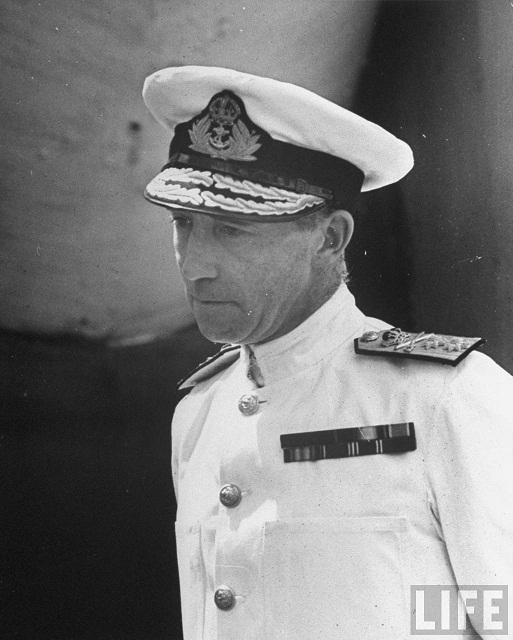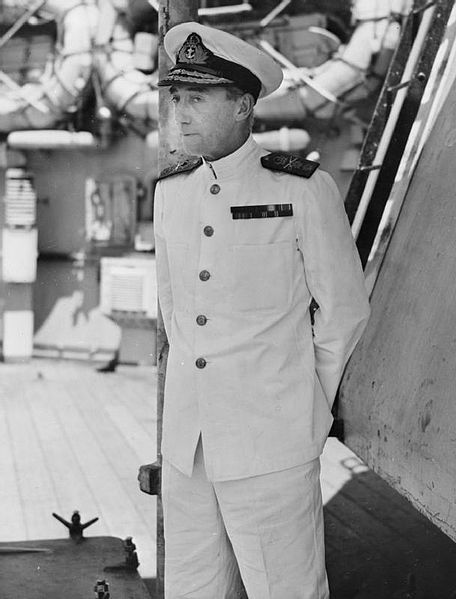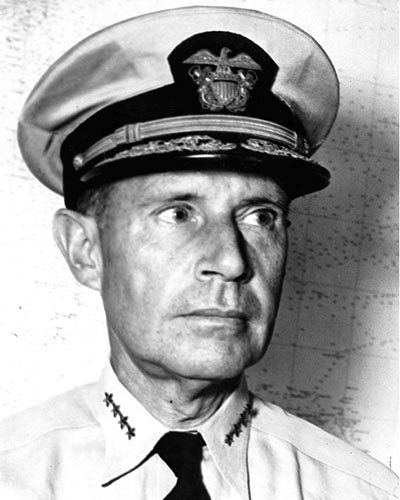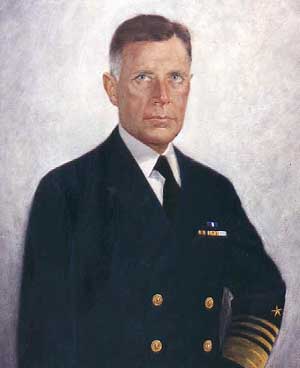<Back to Index>
- Commander of Task Force 57 of the Royal Navy Admiral Henry Bernard Hughes Rawlings, 1889
- Commander of the United States Pacific Fleet Admiral Raymond Ames Spruance, 1886
PAGE SPONSOR


Admiral Sir (Henry) Bernard (Hughes) Rawlings GBE KCB (1889 – 1962) was a Royal Navy officer who went on to be Flag Officer, Eastern Mediterranean during World War II.
Rawlings joined the Royal Navy in 1904 and served in World War I. After the War he worked for the Foreign Office and undertook Military Missions in Poland. He then commanded the destroyer HMS Active and then the cruisers HMS Curacoa and HMS Delhi before becoming Naval Attaché in Tokyo in 1936.
He served in World War II initially commanding the battleship HMS Valiant,
then commanding the 1st Battle Squadron from 1940 before commanding the
7th Cruiser Squadron from 1941 and becoming Assistant Chief of Naval
Staff in 1942. He became Flag Officer, West Africa in 1943 and Flag Officer, Eastern Mediterranean in 1943. He went on to be Second in Command of the British Pacific Fleet with his flag in HMS King George V. He commanded British Task Force 57 in the Pacific from 1944 through the Battle of Okinawa in Spring 1945 and retired in 1946.



Raymond Ames Spruance (July 3, 1886 – December 13, 1969) was a United States Navy admiral in World War II.
Spruance commanded US naval forces during two of the most significant naval battles in the Pacific theater, the Battle of Midway and the Battle of the Philippine Sea. The Battle of Midway was the first major victory for the United States over Japan and is seen by many as the turning point of the Pacific war. The Battle of the Philippine Sea was
also a significant victory for the US. The Navy's official historian
said of the Battle of Midway "... Spruance's performance was
superb... (he) emerged from this battle one of the greatest admirals in
American naval history". After the war, Spruance was appointed President of the Naval War College, and later served as American ambassador to the Philippines.
Spruance was born in Baltimore, Maryland, to Alexander and Annie Spruance. He was raised in Indianapolis, Indiana. Spruance attended Indianapolis public schools and graduated from Shortridge High School. From there, he went on to graduate from the U.S. Naval Academy in 1906, and received further, hands on education in electrical engineering a few years later. His seagoing career included command of the USS Osborne, four other destroyers, and the battleship USS Mississippi (BB-41).
Spruance also held several engineering, intelligence, staff and Naval War College positions up to the 1940s. In 1940 and 1941, he commanded the 10th Naval District and Caribbean Sea Frontier, headquartered at San Juan, Puerto Rico.
In
the first months of World War II in the Pacific, Spruance commanded
four heavy cruisers and support ships that made up Cruiser Division
Five. Spruance’s division was under a task force built around the
aircraft carrier USS Enterprise commanded by Admiral William "Bull" Halsey. Halsey led a series of hit and run raids against the Japanese, striking the Gilbert and Marshall islands in February, Wake Island in March, and carrying out the Doolittle Raid in
April against targets on the Japanese homeland. The raids were
important to morale, setting a tone of aggressive initiative taking, and
also provided invaluable experience for the US Navy.
Admiral Halsey, commander of the Pacific Fleet aircraft carrier force, came down with a severe case of psoriasis just before the battle, which hospitalized him. He recommended Spruance to Pacific Fleet commander Chester W. Nimitz to take his place. Spruance had up to that time been a cruiser division commander, and there was some concern that he had no experience handling a carrier air battle. Halsey reassured him, telling Spruance to rely on his able staff, particularly Captain Miles Browning, a battle proven expert in carrier warfare. Spruance commanded Task Force 16, with two aircraft carriers, USS Enterprise (flagship) and USS Hornet, and was under the overall command of Admiral Frank Jack Fletcher, trailing behind in the damaged USS Yorktown.
The U.S. task force, based on three carriers, faced a Japanese force with four fleet carriers, divided into two groups, a lead group under Admiral Nagumo and a follow - on group under Admiral Yamamoto. The US Navy lost one carrier while sinking all four of the enemy's fleet carriers. The US victory came largely from the toughness of the fighting force, Spruance's combination of coolness plus his caution at just the right moments, and large doses of plain luck. Several waves of US aircraft were beaten badly by the Japanese both at the Island of Midway and at sea around the Japanese task force. Then a large group of US dive bombers happened to find Nagumo's four carriers — with air cover absent. Most of the Japanese strike planes had only returned from the attack on Midway, and the CAP deployed by Nagumo was busy attacking VT-8 torpedo bombers from Hornet. The US dive bombers badly damaged the Japanese carriers, all eventually sinking, which essentially ended the Japanese lead in fleet power in the Pacific. One of the carriers, Hiryu gave a brief respite for the Japanese by sending a strike wave which crippled Yorktown, but additional waves from Enterprise struck the carrier, which forced Hiryu to be scuttled afterwards.
Historian Samuel E. Morison wrote in 1949 that Spruance was subjected to much criticism for not pursuing the retreating Japanese, and allowing the retreating Japanese surface fleet to escape. However, Spruance was recommended for the Navy Distinguished Service Medal by both Fletcher and Nimitz for his role in the battle.
Before
Midway, a small and fractional US Navy in the Pacific faced an
overwhelmingly large and battle hardened Japanese fleet. After Midway,
the Japanese still held a temporary advantage in vessels and planes, but
the setback gave the slow - to - crank - up US industrial production
time to
turn the tables. It also gave the US Navy confidence. Once running at
full speed, American factories handed the allies a huge advantage
against not only the Japanese but also the Germans. At the same time,
American Pacific forces before and after Midway gained crucial combat
experience, so that the Japanese lost the advantage there as well.
After the Midway battle, Spruance became Chief of Staff to the Commander in Chief, Pacific Fleet (CINCPAC) and later was Deputy Commander in Chief. In mid 1943, Spruance was given command of the Central Pacific Force. The command of the vessels which made up the big blue fleet alternated between Admiral William Halsey, at which time it was identified as the Third Fleet and Task Force 38, and Admiral Spruance, in which it became the Fifth Fleet and Task Force 58. The two admirals were a contrast in styles. Halsey was aggressive and a risk taker. Spruance was professional, calculating and cautious. Most common sailors were proud to serve under Halsey; most higher ranking officers preferred to serve under Spruance. Captain George Dyer of the CL Astoria, who served under both Spruance and Halsey, summed up the view of many ship captains:
"My feeling was one of confidence when Spruance was there. When you moved into Admiral Halsey's command from Admiral Spruance's ... you moved [into] an area in which you never knew what you were going to do in the next five minutes or how you were going to do it, because the printed instructions were never up to date.... He never did things the same way twice. When you moved into Admiral Spruance's command, the printed instructions were up to date, and you did things in accordance with them."
From 1943 through 1945, with USS Indianapolis or the USS New Jersey as his flagship, Spruance directed the campaigns that captured the Gilbert Islands, Marshall Islands, Marianas, Iwo Jima, and Okinawa.
Spruance directed Operation Hailstone against the Japanese naval base Truk in February 1944 in which twelve Japanese warships, thirty - two merchant ships and 249 aircraft were destroyed. While screening the American invasion of Saipan, in June 1944 Spruance also defeated the Japanese fleet in the Battle of the Philippine Sea. Although he broke the back of the Japanese naval air force by sinking 3 carriers, 2 oilers and destroying about 600 enemy airplanes — so much so that for ADM Halsey in the Battle of Leyte Gulf a few months later the remaining Japanese carriers were used solely as decoys due to the lack of aircraft, and aircrews to fly them — Spruance has been criticized for not being aggressive enough in exploiting his success in the Philippine Sea. Buell quotes Spruance speaking with Morison: "As a matter of tactics I think that going out after the Japanese and knocking their carriers out would have been much better and more satisfactory than waiting for them to attack us, but we were at the start of a very important and large amphibious operation and we could not afford to gamble and place it in jeopardy."
Spruance succeeded Fleet Admiral Chester Nimitz as Commander in Chief, US Pacific Fleet and Pacific Ocean Areas in November 1945.
Spruance's promotion to Fleet Admiral was blocked multiple times by Congressman Carl Vinson, a staunch partisan of Admiral William Halsey, Jr. Congress eventually responded by passing an unprecedented act which specified that Spruance would remain on a full admiral's pay once retired until death. Spruance was President of the Naval War College from February 1946 until he retired from the Navy in July 1948. He was appointed as American ambassador to the Philippines by President Harry Truman, and served there from 1952 to 1955.
Spruance died in Pebble Beach, California, in 1969. He was buried with full military honors alongside his wife, Margaret Dean, Fleet Admiral Chester Nimitz, his longtime friend Admiral Richmond K. Turner, and Admiral Charles A. Lockwood, an arrangement made by all of them while living.
The destroyers USS Spruance (DD-963), lead ship of the Spruance - class of destroyers, and USS Spruance (DDG-111), 61st ship of the Arleigh Burke class destroyer, were named in his honor.